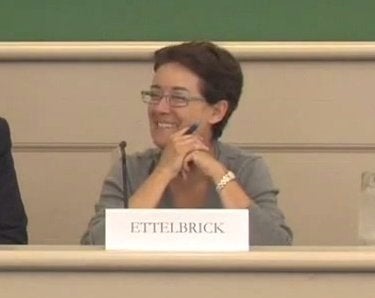
Time is deceptive and uneven in its passing. In some respects it is hard to imagine that it has been a year since Paula Ettelbrick passed away. In other respects it seems like more than a year has transpired, given the significant advances LGBT people have made in their search for acceptance.
Paula influenced me deeply as I wrote my masters dissertation. Paula recruited me to work with her at the Stonewall Community Foundation, to inspire a stronger, healthier, and happier LGBT New York City. Paula was an iconic LGBT-rights crusader. In the brief time we shared together she was a mentor, a friend, and a source of inspiration to me. It was impossible not to like Paula personally. Politically, Paula was much more controversial.
Paula will probably always be best remembered for her 1989 OUT/LOOK article, "Since When Is Marriage a Path to Liberation?" and her positions within the marriage-equality debate. Juxtaposed against Tom Stoddard's "Why Gay People Should Seek the Right to Marry," Paula argued that while LGBT Americans should have the right to marry, "obtaining a right does not always result in justice." For Paula, placing marriage equality so high on the agenda of the gay-rights movement was a mistake, distracting activists from a broader social-justice conversation.
Paula believed that fighting for and winning marriage equality would result in LGBT Americans assimilating to an unsatisfactory status quo as they organized themselves into married monogamous couples. As Paula noted, "the law provides no room to argue that we are different, but are nonetheless entitled to equal protection." If marriage equality became the top priority, Paula envisioned a scenario wherein LGBT Americans might antithetically abandon their "gay" cultural identity and rescind their commitment to honoring the validity of varied human relations. In her own words, "making legal marriage for lesbian and gay couples a priority would set an agenda of gaining rights for a few, but would do nothing to correct the power imbalances between those who are married (whether gay or straight) and those who are not. Thus, justice would not be gained."
There were larger structural issues to be addressed in Paula's thinking. In 1996 Paula noted, "The problem in this area is not so much that lesbian and gay couples cannot marry. Rather, it is that all of the legal and social benefits and privileges constructed for families are available only to those families joined by marriage and biology." Why would we want to join an exclusive club we once sought to dismantle? Why not establish a new club?
Given Paula's position, it was a bit ironic to personally discuss with Paula our shared jubilation at the passing of New York's landmark Marriage Equality Act, which granted millions of LGBT New Yorkers the right to marry in June 2011. But then again, perhaps it was not so odd, because Paula was a true advocate for LGBT rights, and like all of us she was thrilled by the advances we were able to make, and by the rights we were able to secure. Paula and I both supported total inclusivity, and even if we knew including some people still left others out, we were pragmatic about our progress. As marriage equality moved forward full steam ahead, Paula aimed not to derail the train but to make sure there were multiple cars on the train, carrying people to more than one destination. Paula continued to advocate for diversified family forms and their legal and social acceptance. It didn't make sense to have a one-size-fits-all mold that ignored the beautiful variations that our different life experiences produce.
More important than any specific position Paula ever endorsed was her insistence on fighting for a society that encouraged everyone to accept, embrace, and celebrate our human diversity. Whether it came to recognizing, respecting, and protecting non-normative kinship structures or dismantling antiquated and unfair hierarchical structures, Paula always fought for the disenfranchised. Her legacy is larger than the collection of written work she leaves behind, larger than the scholarship programs, grant programs, and advocacy programs named in her honor. The Paula Ettelbrick legacy is a constructive dialogue that we hope might inform future activists. The hope is that generations to come will adopt Paula's perspective and provide equal protections and award equal respect not only to those who are the same but to those who are different. The dream is that social justice will be achieved for all people regardless of where they came from or what lifestyle choices they make.
In one of her last interviews, Paula admitted that in her career she was "not just looking for fixes, but going after the central problem." On Oct. 7 it will have been exactly one year since Paula's untimely passing, but her legacy will live on forever as long as people refuse to accept short-term fixes and instead pursue long-term solutions to the systemic problems that continue to plague society and prevent human liberation.
Citations:
1. Paula Ettelbrick, "Since When Is Marriage a Path to Liberation?" OUT/LOOK, Fall 1989: 14-16.
2. Paula Ettelbrick, "Since When Is Marriage a Path to Liberation?" OUT/LOOK, Fall 1989: 14-16.
3. Paula Ettelbrick, "Since When Is Marriage a Path to Liberation?" OUT/LOOK, Fall 1989: 14-16.
4. Paula Ettelbrick, "Wedlock Alert: A Comment on Lesbian and Gay Family Recognition," 5 J.L.& POL'Y 107, 122 (1996).
5. Chris Geidner, "Domestic Disturbance: Before DOMA, there was another debate over marriage -- within the gay and lesbian community" Metroweekly.com. Metro Weekly, 4 May 2011. Web. <http://www.metroweekly.com/feature/?ak=6213>.